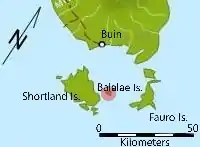Shortland Islands
The Shortland Islands archipelago is part of the Western Province of the Solomon Islands, at 6.92°S 155.88°E. The island group lies in the extreme northwest of the country's territory, close to the southeast edge of Bougainville Island, Papua New Guinea.[1]
The largest island in the archipelago is Shortland Island (originally called Alu).[2] Other large islands include Balalae, Faisi, Fauro, Magusaiai, Masamasa, Ovau, Pirumeri and Poporang.
Early European involvement
The island group, and the largest island, were named by Royal Navy officer John Shortland in 1788. Shortland was the naval commander of a 1777–79 voyage by the First Fleet to establish a penal colony at Botany Bay, Australia.[3]
Germany later claimed the islands and owned them as part of the North Solomon Islands Protectorate until 1900.
World War II
On March 30, 1942, Japanese war ships entered Shortland Harbor and landed two special naval landing force platoons and met no resistance. One platoon remained in the area to begin establishing Shortland Harbor Seaplane Base. They established the base, seaplane moorings and fortifications in Tuha Channel and the adjoining land on the southeastern portion of Shortland Island, on Faisi and on the northern portion of Poporang.[4]
On the night of 29–30 June 1943, USS Montpelier (CL-57) and three other cruisers bombarded Poporang Island in preparation for the invasion of New Georgia. The Allies considered invading the seaplane base in August 1943, but chose instead to bypass the Shortlands for Bougainville and the Treasury Islands, leaving the Shortlands under Japanese control until the war's end. On 1 November 1943, Montpelier shelled the Japanese defenses on Poporang and Balalae.
On 8 January 1944, an Allied force of two light cruisers and five destroyers bombarded the installations on Faisi, Poporang, and Shortland Island.[5] In March 1944, planes from the USAAF's 70th Fighter Squadron used reconnaissance photographs taken by the 17th Reconnaissance Squadron to strike the seaplane base, claiming eight float planes and an IJN destroyer.[6] On 20 May 1944, Montpelier received light damage from return fire when she and two other light cruisers, along with eight destroyers, bombarded shore installations on Shortland, Poporang, and Magusaiai Islands.[5] On 1 October 1944, the US Navy's Special Air Task Force (SATFOR)[7] launched four TDR drones on antiaircraft gun positions on Poporang and Balalae.[5]
Gallery

NASA Satellite Imagery of Shortland Island .jpg.webp)
Fauro Island 
Map Showing Shortland Archipelago
See also
References
- "Shortland Islands". Solomon Islands Historical Encyclopaedia 1893-1978. Retrieved 4 August 2018.
- Ray, Sidney Herbert (1926). Comparative Study of the Melanesian Island Languages. Melbourne: Melbourne University Press. p. 584. ISBN 978-1-107-68202-3. Retrieved 2020-03-28.
- McMartin, Arthur (1967). Shortland, John (1739 - 1803). Australian Dictionary of Biography, Volume 2. Melbourne: Melbourne University Publishing. pp. 442–443. ISBN 978-0-522-84459-7. Retrieved 2020-03-28.
- "Map of target area including Faisi Island and Shortland Island". United States Army Air Force, 13th AF. Pacific Wrecks. 1943-04-11. Retrieved 2020-03-28.
- Cressman, Robert (2000). "Chapter VI: 1944". The official chronology of the U.S. Navy in World War II. Annapolis, Maryland: Naval Institute Press. ISBN 978-1-55750-149-3. OCLC 41977179. Retrieved 2020-03-28.
- Rohfleisch, Kramer J. (1950). "Chapter 7: The Central Solomons". In Craven, Wesley Frank; Cate, James Lea (eds.). Vol. IV, The Pacific: Guadalcanal to Saipan, August 1942 to July 1944. The Army Air Forces in World War II. Chicago: University of Chicago Press. pp. 211–212. OCLC 769332570. Retrieved 2020-03-28.
- Fitzpatrick, Connor (2016-10-20). "WWII Naval Drone Training". Military History of the Upper Great Lakes. Michigan Technological University. Retrieved 2020-03-28.